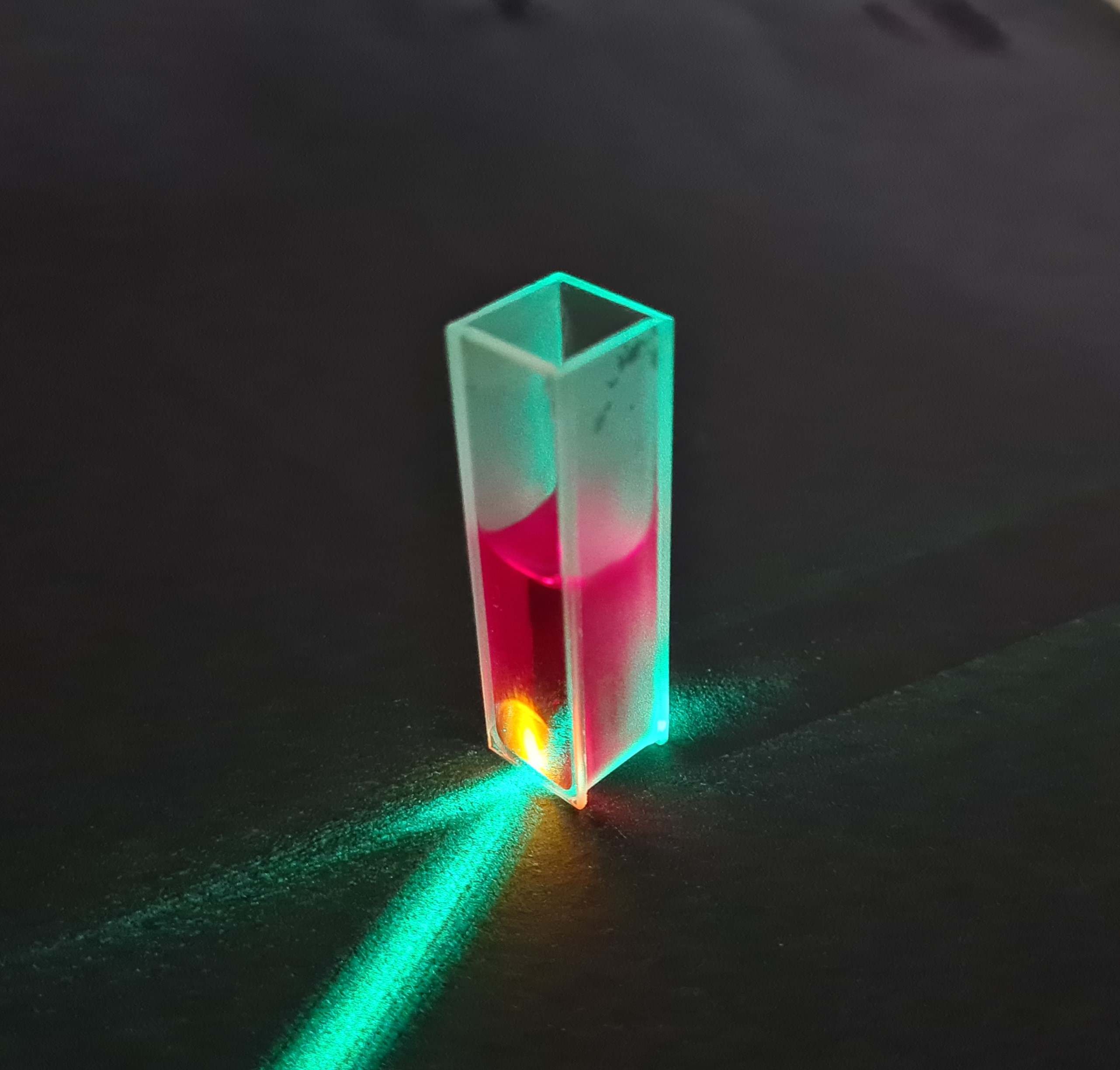


Rhodamine is a fluorescent dye that is widely used in many applications such as biochemistry, laser physics and microscopy. This application note shows how rhodamine in powder form can be prepared and measured for fluorescence measurement with our DIY spectrometers. The aim is to record a fluorescence spectrum and characterize the properties of rhodamine.

For simple fluorescence experiments, a technical quality of rhodamine is completely sufficient (often > 90 % purity). This can be obtained relatively easily and inexpensively from standard laboratory suppliers. The use of more expensive rhodamine in analytical quality (≥ 98 – 99 %) is not necessary.
For our measurement, we use rhodamine B, a small amount of which is first added to a clean glass container in preparation for the measurement. Ethanol is then added as a solvent and the mixture is carefully stirred until the rhodamine has completely dissolved. Rhodamine is highly soluble in ethanol, resulting in a clear, intensely colored solution. In the final step, the solution is filled into a quartz cuvette to ensure a uniform and reproducible measurement.
Warning: Some rhodamines (especially rhodamine B) are suspected of having a mutagenic or carcinogenic effect. Rhodamine B is therefore not approved for use in the food sector in the EU and the USA. The use of gloves and safety goggles is recommended when working with rhodamine in the laboratory!
Rhodamine can be excellently excited with a green or blue LED (e. g. 470 – 520 nm). The emission is intense enough to be detected even at very low concentrations—ideal for demonstrating fluorescence sensitivity. A comparison with known concentrations can be made for quantitative evaluation.
In our experiment, however, a laser diode module with 520 nm is used, as this allows the fluorescence to be highlighted particularly well (see image at the top of this page). The yellowish fluorescence is clearly visible where the widened laser beam hits the cuvette with the otherwise reddish liquid.
To measure the fluorescence spectrum, the laser beam is directed onto the cuvette at an angle of 45 degrees, so that the light emitted by the fluorescence can also be recorded at an angle of 45 degrees by the light guide and fed to the spectrometer.
The spectra were recorded with one of our DIY spectrometers.
The recorded spectrum should show a clear fluorescence emission in the yellowish-reddish range, which indicates the characteristic emission of rhodamine. The intensity of the fluorescence signal depends on the concentration of the solution and the settings of the spectrometer.
The light from the exciting laser diode dominates in the green range around 520 nm. Due to the relatively long integration time for recording the fluorescence signal, the CCD sensor of the line scan camera used in the spectrometer reaches saturation here. The spectral broadening of the actually very narrow laser line observed in this way is therefore an artifact and not real. For a possibly desired suppression of the exciting light in the spectrum, an additional optical edge filter could be used, which only allows light from 540 nm to pass through, for example.
Rhodamines are very interesting fluorescent dyes with a wide range of applications—they are a real classic, especially in research. These dyes belong to the xanthene dye family. The best-known representatives are rhodamine B, rhodamine 6G and rhodamine 123, which are characterized by high fluorescence quantum yields and good photophysical stability.
Rhodamine B and 6G are used as color tracers in running waters, wells and groundwater models. Their advantage is that these substances can be detected extremely well even in the smallest concentrations by fluorescence measurement. Applications include leak detection as well as flow and residence time measurement.
Rhodamine 123 is preferably used for labeling mitochondria. Rhodamine derivatives, on the other hand, are used for coupling to proteins or antibodies (e. g. in fluorescence microscopy or flow cytometry). Good cell permeability and high fluorescence enable sensitive in vivo studies.
Rhodamine 6G is a popular laser medium dye for diode or solid-state pumped dye lasers due to its high efficiency.
Rhodamine B in particular is used for dyeing textiles, soaps and paper. However, it is not used in cosmetics or food because of its potential toxicity.
There are a variety of uses in safety markings, UV inks or neon-colored plastics. In combination with black light, it produces a strong glowing effect.
Rhodamine is also used in artificial colors, neon paints and make-up products.
 Would you like to replicate the experiment—in your laboratory or teaching environment? Feel free to contact us—we will assist you with planning, setup, calibration, and selecting the right components. Eureca offers advice based on many years of expertise in optoelectronics, optics and spectroscopy—from DIY setups to OEM solutions. Feedback is expressly welcome: Please share your experiences, results, or suggestions for improvement with us.
Would you like to replicate the experiment—in your laboratory or teaching environment? Feel free to contact us—we will assist you with planning, setup, calibration, and selecting the right components. Eureca offers advice based on many years of expertise in optoelectronics, optics and spectroscopy—from DIY setups to OEM solutions. Feedback is expressly welcome: Please share your experiences, results, or suggestions for improvement with us.
Here you can easily ask a question or inquiry about our products:
Last update: 2025-31-10
